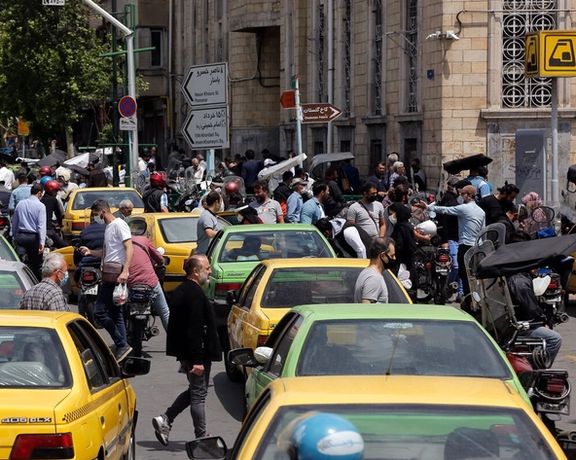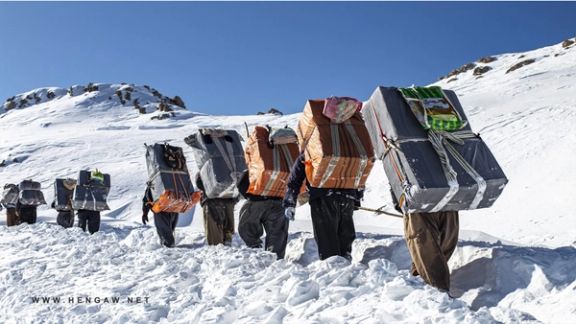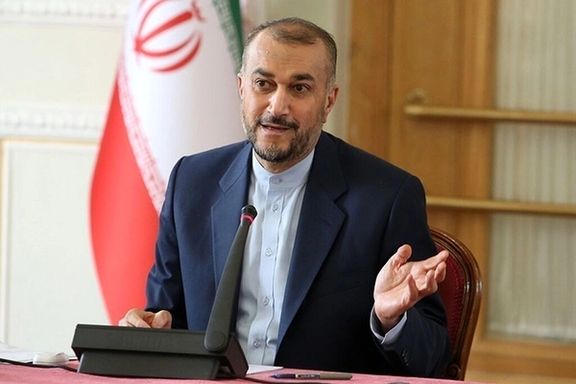Iranian Court Orders US To Pay Over $1B For Supporting The Shah

A court in Tehran has ruled that the US government should pay over one billion dollars in damages for what it called "US support for the Pahlavi dynasty."

A court in Tehran has ruled that the US government should pay over one billion dollars in damages for what it called "US support for the Pahlavi dynasty."
This follows a report that 15 individuals who were allegedly jailed during the monarchy, prior to the 1979 revolution, filed a lawsuit accusing the US of supporting the Pahlavi dynasty in establishing its security and intelligence service, SAVAK.
The plaintiffs claim that years of torture by the Shah's secret police SAVAK left them with “physical, mental, and social harms.”
However, no details were provided about who those plaintiffs are, and what evidence exists to support for their claims.
Late last year, Iranian exiled prince Reza Pahlavi said that most of those held by SAVAK were agents of the Soviet Union. He also added that Iran's present Supreme Leader, Ali Khamenei, was one of those trained by the KGB in Palestinian camps in Lebanon.
SAVAK was the main secret police from 1957 to 1979 when the Iranian Revolution took place, after which Prime Minister Shapour Bakhtiar ordered its dissolution.
The Islamic Republic is recognized by UN bodies and rights groups as one of the world's most notorious violators of human rights. Reports of torture have been wide-ranging in connection with methods employed by Iranian intelligence and security forces, especially during recent protests and the resulting crackdown. Amnesty International has reported on cases of sexual violence, physical torture, and other cruel treatments made against detainees, including children. Such actions involve raping, beating, and subjecting to electric shocks.
Other reports have cited the use of pharmacological torture, whereby political prisoners are subjected to psychoactive drugs that produce grave psychic and physical distress. Some reports have indicated that the use of psychiatric torture have increased since the 2022 Women, Life, Freedom protests.

Responding to overnight attacks on the positions of an Iran-backed group in Iraq, an analyst told Iran International that Israel is trying to stop Tehran’s proxies from joining the conflict.
“Iran’s proxy forces can retaliate to the recent strike on [airbase in] Esfahan and Israel wants to prevent that from happening,” said Masoud Alfak, adding that “Israel now sees the best defense in an offense.”
On Friday, explosions were heard in Esfahan's 8th Shekari Air Base as Israel reportedly launched a widely anticipated strike in retaliation to a large-scale Iranian missile and drone attack over the weekend.
In less than 24 hours, airstrikes hit the headquarters and a major base of Iran-backed Hashd al-Shaabi militia (Popular Mobilization Forces) in the Babylon governorate of eastern Iraq to the south of the capital city, Baghdad.

According to Alfak, a vast network of hybrid warfare is currently underway between Israel and Iran and its proxies in the region. “Israel considers Tehran-backed proxy groups as part of its conflict with Iran.”
The Dubai-based analyst remarked that as long as the war in Gaza continues and Iran-Israel tensions persist, Tehran-backed proxies will continue their destabilizing actions in the region and will refuse to stay peaceful.
No one has claimed responsibility for the overnight strikes on Hashd al-Shaabi positions in Iraq. In a post on X, the US Central Command (CENTCOM) dismissed reports that Washington had a part in the operation. Citing an unnamed Israeli official, CNN reported that Israel also denied involvement in the incident.
For months after the start of the Israel-Hamas war on October 7, the Iranian government avoided direct involvement in the conflict and used its proxies such as Yemeni Houthis, Hashd al-Shaabi, and Hezbollah to target Israeli and American interests in the region.
Tensions between Iran and Israel have risen sharply over the past weeks. On April 1, Israel launched a precision missile strike on Iran's consulate building in Damascus, including Mohammad Reza Zahedi, the highest-ranking commander of the Iranian Revolutionary Guards Quds Force (IRGC-QF) in Lebanon and Syria. In retaliation, Iran launched its first ever direct strike against Israeli territory on April 14 with more than 350 drones and cruise and ballistic missiles.
In a post on X, Jason Brodsky, Policy Director at United Against Nuclear Iran (UANI), attributed the overnight strikes in Iraq to Israel. “On April 17, Iraq’s national security advisor Qasim Al-Araji, a member of IRGC terrorists-backed Badr Organization, said Iran’s regime’s attack on Israel on April 13 created ‘a new deterrent policy’ in the region. And this is Israel’s response to him tonight in Iraq,” Brodsky pointed out.
Since October 7, Iran-backed forces in Iraq have been threatening to target Israel. Their anti-Israel rhetoric intensified after the April 1 attack in Damascus. Following the incident, the Iranian proxies in Iraq claimed two drone attacks on Israeli territory, one in Haifa and another in Golan Heights.
Furthermore, Tehran-backed Iraqi Hezbollah voiced its readiness to arm and equip 12,000 forces of “the Islamic resistance” in Jordan, threatening that country’s stability and the Hashemite kingdom.
“This threat is about opening a broad front against the Zionist regime, which is probably the most dangerous of all fronts because it could geographically threaten all the cities of the occupied territories and could facilitate attacks against many of the most sensitive targets, including Tel Aviv and [Israel’s] nuclear facilities,” Iranian semi-official news agency ISNA reported on April 4.

With the recent steep fall in the value of Iran's currency, rial, and surging inflation, fares have surged in public transport in Tehran, with taxi fares increasing as much as 45%.
The new tariffs, which came into force Saturday, would also include an average 28 percent hike for metro services and a 26 percent rise for buses. The changes were implemented after obtaining approval from the Tehran City Council and the Tehran Governorate.
The rise in transportation costs comes at a time when the country is experiencing one of the acutest economic crises in recent Iranian history. Observers caution that the fare hikes may exacerbate inflationary pressures further, as the cost of goods transportation also climbs, leading to higher consumer prices.
The high transport costs might also drive commuters to lower-cost but environmentally unfriendly alternatives like personal vehicles or motorcycles which will escalate traffic congestion further, increase emission levels, and degrade air quality.
This comes as a recent study revealed that one in three Iranians lives below the poverty line. This would mean that a family of three in Iran needs at least $400 a month to come to a level of at least meeting essential needs. However, the new minimum monthly wage has been set at 115 million Iranian rials or about 170 US dollars.
This has led to hard times for citizens, where many people find it difficult to afford some of the most essential dietary requirements, such as meat, fruits, and vegetables. Although authorities have given repeated vows to control inflation, the pledges have frequently fallen short, echoing previous unmet commitments.

The dangers facing Iranian cross-border porters, known as Kolbars, have intensified with numerous reports of fatalities and injuries at the hands of Iranian border guards.
“In the past four weeks, five kolbars have been killed by Iranian border guards in the border areas of Nowsud, Kermanshah Province, and Baneh, Kurdistan Province. Another five kolbars have died from frostbite, heart attacks and falls from mountain heights,” Kurdistan Human Rights Network said.
This week, Seyvan Dast-Afkan, a Kolbar in his thirties, became the latest victim when he was shot by Iranian border guards at the Tateh Pass in the Hawraman region of Sarvabad in Iran’s Kurdistan Province.
Dast-Afkan and his group were reportedly targeted without warning, the Kurdistan Human Rights Network (KHRN) said. According to the human rights group Hengaw, Dast-Afkan hails from Darreh Peyman in Marivan, Kurdistan Province. He leaves behind a family and a young child.
Human rights groups say the recent incidents highlight the grave risks these laborers continue to face, when they carry goods on their backs across Iran’s borders – often journeying long distances through the mountainous regions into Iraq.
In another case this month, two separate shootings by Iranian border guards resulted in fatalities. Mehrdad Abdollahzadeh, a 20-year-old Kolbar from Maraghan village in Sardasht, fell to his death after being targeted in the mountainous areas of Bitush village.
Simultaneously, Omid Saeidi met a similar fate in the Bastam border area, with his dead body abandoned by the Iranian border guards, until he was discovered hours later by locals.
Late March, two kolbars lost their lives and four others sustained injuries in falls from mountainous terrain in Hawraman and Sardasht. Shoresh Shokri, among the fallen, succumbed to his injuries en route to receive medical care.
The brutality at the hands of the Iranian border guards extends beyond shootings.
Fardin Veysi endured severe injuries on April 6 after being fired on by Iranian border guards in the Hangeh-ye Zhal border area of Baneh, Kurdistan Province. The use of pellet guns at close range left him with critical wounds to his abdomen and hand.
According to Kolbar News, between March 2023 and March 2024, 444 Kolbars in the border areas and inter-provincial routes between West Azerbaijan, Kurdistan, and Kermanshah provinces were killed or injured due to factors such as direct shooting by regime military forces, avalanches, frostbite, stepping on mines, falling from mountains and heights, and other causes.
Out of the 444, a total of 373 Kolbars were either killed or injured due to direct shooting by military forces.
Kolbars are also often victims of Iran’s systematic disregard for due process in judicial proceedings.
Last month, Daniyal Mam Ahmed, a 17-year-old from Marivan, in the Kurdistan province of Iran, received a verdict of two years imprisonment along with 74 lashes by the Iranian judiciary.
Hengaw reported that Mam Ahmed was arrested by Iranian government forces in March, while working as a Kolbar at the "Qalqaleh" border – and remains jailed in Marivan's central prison.

Iran’s Foreign Minister Hossein Amir-Abdollahian refrained from acknowledging that Israel had a part in the Friday attack on a airbase in Iran as Tehran attempts to quell war talk.
“It has not been proven to us that there was a connection between this and Israel,” he said in an interview with NBC News.
Early Friday morning, explosions were heard in Esfahan's 8th Shekari Air Base as Israel reportedly launched a widely anticipated strike in retaliation to an Iranian aerial assault last weekend.
In an attempt to downplay the incident, Amir-Abdollahian said what happened “was not a strike.” According to Iran’s top diplomat, the projectiles used in the incident were “more like toys that our children play with.”
“They took off from inside Isfahan and they flew for a few hundred meters and then they were downed and struck by our air defense,” he went on to say, in what appears to be a veil to avoid retaliation as international powers push for calm.
Meanwhile, New York Times reported that according to the analysis of satellite imagery, the Friday precision strike on Isfahan (Esfahan) damaged or annihilated the “flip-lid” radar, a significant part of the air defense system in Shekari Air Base.
Prior to the incident, four trucks with missiles were positioned around the radar but the satellite images show they were not damaged in the strike. “The fact that they appear undamaged indicated that the attack had a very precise target,” New York Times wrote, citing a former US government imagery analyst.
Israel has not officially commented on the attack.
Tensions between Iran and Israel have risen sharply over recent weeks. On April 1, Israel launched a precision missile strike on Iran's consulate building in Damascus, killing 7 IRGC senior officers, including two senior commanders. In retaliation, Iran launched its first ever direct offensive against Israeli territory last weekend with more than 350 drones and cruise and ballistic missiles. Most were intercepted in a joint operation between Israel and its allies in a US-led coalition.

US and Iraqi companies have signed two deals, seemingly aiming to make the country independent from Iranian gas and electricity imports that provide billions of dollars to Tehran.
The deals are meant to capture Iraqi associated gas from oilfields, currently being flared due to lack of gas collecting equipment.
The US State Department released a joint statement after sealing the deal with Iraq, saying that the US has the potential to harness immense natural gas resources, invest in new energy infrastructure and renewables, and achieve energy self-sufficiency by 2030.
“The United States commended Iraq for its progress on gas capture and work on commercializing associated gasses,” the statement read.
Currently Iraq flares about 18 billion cubic meters (bcm/yr) of associated gas, ranking the second globally after Russia.
This amount of gas waste is two times more than Iraq’s annual gas imports from Iran.
Since the United States imposed banking sanctions on Iran in 2018, Iraq was not able to make cash payments to Iran, leading to the accumulation of around $11 billion in unpaid bills. The Biden administration, however, offered waivers to Iraq starting in June 2023 and the debt was paid in Oman, from where Iran is supposed to spend the money for buying "unsanctionable" goods.
However, critics have slammed the Biden administration for this decision, arguing that money is fungible and any hard currency Iran is able to access means that it can spend other currency resources on its military and other destabilizing activities.
Iraq's electrical grid has for years been dependent on gas imports from Iran to run its power generation plants. Iraq loses 4,000 to 5,000 MW of its electricity generation in some months, especially in winter and summer, due to halting Iranian gas and electricity deliveries to this country. Iran’s gas shortage soars to 250-300 mcm/d in winters and faces a 14,000 MW electricity shortage in summers, forcing it to reduce supplies to Iraq.
The country needs 40,000 MW of electricity, but its current generation capacity stands at 27,000 MW, of which 30% uses Iranian gas.
Iraq has projected to stop gas flaring by 2028 and reach energy self-sufficiency by 2030. It is working to reduce its heavy reliance on Iranian energy supply, which is subject to sanctions, requiring the US to issue waivers every four months.
Though Iraq recently extended a gas import deal with Iran for next five years, it has been trying to diversify energy import sources, including Turkmen gas import through Iran.
The joint statement says that US commended Iraq for its considerable work on increasing regional connectivity, particularly in energy interconnections with Jordan, Saudi Arabia, and countries of the Gulf Cooperation Council: “After years of work to build its interconnection with Jordan, Iraq is receiving 40 megawatts of electricity for the Iraqi people; future phases would increase capacity to 900 megawatts”.
Iraq’s gas and power deals
The agreements, signed in Washington in the presence of Iraqi Prime Minister Mohammed Shia al-Sudani and US officials, aims to capture above 3 bcm/yr of associated gas at the Bin Umar oilfield.
The memorandums of understanding signed between US companies including KBR, Baker Hughes and GE.N. as well as local Halfaya Gas Company, with Iraq's South Gas Company to capture flaring gas at Umar oilfield and construct a 400 km pipeline to transit the gas to processing facilities.
Iraq's oil ministry announced last month that it would work with Siemens Energy and SLB, formerly known as Schlumberger, to process associated gas.
Geoffrey Pyatt, assistant secretary for energy resources at the US State Department said the projects would be developed over the next couple of years.
Iraq had several deals with Western companies to capture associated gas, signed in the late 2010s. It could increase gas production by 30% between 2012-2017, but the growth stalled then due to plunging oil prices and government’s revenues.






